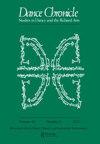比满足眼睛:对舞蹈研究的关键制度研究
IF 0.1
3区 艺术学
0 DANCE
引用次数: 0
摘要
本期特刊回归二十年前《舞蹈纪事》探讨的一系列主题。萨莉·贝恩斯(Sally Banes)在2002年的一期杂志《他们跳舞的地方:赞助人、机构、空间》(Where They dance:Patrons,Institutions,Spaces)中开始介绍一系列文章,其中包括贝恩斯(Banes)、林恩·加拉福拉(Lynn Garafola)、珍妮斯·罗斯(Janice Ross)和普尼玛·沙阿(Purnima Shah)的作品。Banes指出,这组文章探讨了她所说的“批判性机构研究”,即考虑形成音乐会舞蹈可能性条件的机构和赞助人的研究。Banes引用了视觉艺术中的制度批判、博物馆研究的兴起,以及“左翼艺术批评的悠久传统——尤其是马克思主义批评”对舞蹈研究中新兴问题的影响。二十年后,我们提出了Banes提出的问题,并反思了舞蹈研究是如何发展出分析舞蹈相关制度背景的框架的。我在2018年遇到了这个问题,在加入《舞蹈纪事报》担任编辑之前,我正在为一篇关于舞蹈赞助及其与房地产开发的联系的文章撰写文献综述。我被贝恩斯的跨学科联系和对马克思主义分析的明确引用所吸引——这在舞蹈出版物中是罕见的。在约伦·梅格林的邀请下担任编辑时,我决定在杂志中挑选一些对我作为一名研究人员产生影响的特定线索。这期特刊以该领域最近的学术成果为基础,对支撑舞蹈实践的制度结构和物质关系进行了批判性的描述。除了在舞蹈和表演研究方面的工作外,其他领域的一系列丰富的调查也对机构的政治、动态和功能进行了尖锐而富有启发性的描述。在视觉艺术领域,评论家和历史学家一直在争论艺术品的功能和后果,这些功能和后果预示着它们与资助者和呈现机构的关系。文化部门的许多团体已经采用了工人调查方法——一种从劳动而非管理的角度研究组织的模式——从而深入了解艺术组织内部的劳动斗争。艺术史和文学研究领域的马克思主义者继续完善和完善理解艺术和文化在资本主义中的政治经济作用的框架本文章由计算机程序翻译,如有差异,请以英文原文为准。
More than Meets the Eye: Towards Critical Institutional Research in Dance Studies
This special issue returns to a set of themes explored in Dance Chronicle twenty years ago. “There is more to dance than meets the eye,” Sally Banes begins the introduction to a sequence of articles within a 2002 issue of the journal titled, “Where They Danced: Patrons, Institutions, Spaces,” featuring work by Banes, Lynn Garafola, Janice Ross, and Purnima Shah. Banes notes that this collection of articles explores what she calls “critical institutional studies,” or research that considers the institutions and patrons that form the conditions of possibility for concert dance. Banes cites the influence of institutional critique in the visual arts, the rise of museum studies, as well as “a long tradition of left-wing art criticism—especially Marxist criticism,” on emerging inquiries in dance studies. Two decades later, we pick up the questions that Banes poses and reflect on how dance studies has developed frameworks for analyzing the institutional contexts surrounding dance. I encountered this issue in 2018, prior to joining Dance Chronicle as an editor, when I was working on a literature review for an article I was writing about dance patronage and its connection to real estate development. I was drawn to Banes’s interdisciplinary connections and explicit invocation of Marxist analysis—a rare sight in a dance publication. When stepping into an editorial role following Joellen Meglin’s invitation, I decided to pick up particular threads within the journal that had been generative for me as a researcher. This special issue builds on recent scholarship in the field that has contributed critical accounts of the institutional structures and material relations that undergird dance practices. In addition to work within dance and performance studies, a rich set of inquires in other fields has developed sharp and illuminating accounts of institutions—their politics, dynamics, and functions. In the visual arts, critics and historians have debated the function and consequences of artworks that foreground their relationship to funders and presenting institutions. A number of groups within the cultural sector have taken up workers’ inquiry methodologies—a mode of studying organizations from the perspective of labor rather than management—providing insight into labor struggles within arts organizations. Marxists in both art history and literary studies have continued to hone and sharpen frameworks for understanding the political economic role of art and culture in a capitalist
求助全文
通过发布文献求助,成功后即可免费获取论文全文。
去求助
来源期刊

DANCE CHRONICLE
DANCE-
CiteScore
0.40
自引率
0.00%
发文量
22
期刊介绍:
For dance scholars, professors, practitioners, and aficionados, Dance Chronicle is indispensable for keeping up with the rapidly changing field of dance studies. Dance Chronicle publishes research on a wide variety of Western and non-Western forms, including classical, avant-garde, and popular genres, often in connection with the related arts: music, literature, visual arts, theatre, and film. Our purview encompasses research rooted in humanities-based paradigms: historical, theoretical, aesthetic, ethnographic, and multi-modal inquiries into dance as art and/or cultural practice. Offering the best from both established and emerging dance scholars, Dance Chronicle is an ideal resource for those who love dance, past and present. Recently, Dance Chronicle has featured special issues on visual arts and dance, literature and dance, music and dance, dance criticism, preserving dance as a living legacy, dancing identity in diaspora, choreographers at the cutting edge, Martha Graham, women choreographers in ballet, and ballet in a global world.
 求助内容:
求助内容: 应助结果提醒方式:
应助结果提醒方式:


